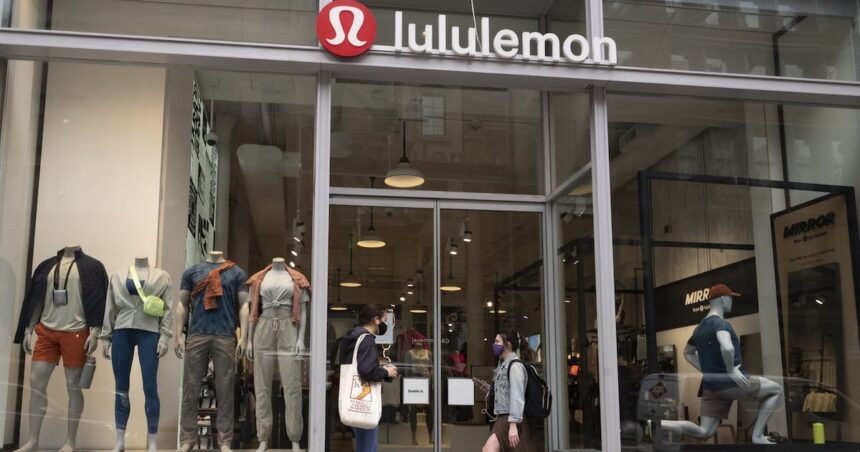I looked up from my coffee in Toronto’s King East Design District – where athleisure-clad professionals create an unintentional runway of $100+ leggings – to read news that perfectly encapsulated modern retail tension. Lululemon, Canada’s premium activewear giant, is suing Costco over alleged copycat leggings, and the case represents something far bigger than spandex.
Canadian-born Lululemon filed the lawsuit in U.S. federal court claiming Costco’s $17 leggings with crossed waistbands infringe on their distinctive $98-$128 Align pant design. The legal battle centers on what the company describes as their signature “Align waistband,” which features a distinctive crossover design that Lululemon claims is immediately recognizable to consumers as their intellectual property.
“This is about more than just leggings. It’s about whether distinctive design elements deserve protection in mass market retail,” says Suzan Clarke, intellectual property attorney at Osler Hoskin & Harcourt. “Fashion brands are increasingly aggressive about protecting what they see as their visual signatures.”
The dispute highlights the accelerating collision between premium and budget retail strategies. Costco has built its $238 billion business model partly on offering near-identical versions of products at dramatic discounts – from Kirkland vodka that insiders say is Grey Goose to golf balls that perform like Titleist. The warehouse retailer declined to comment specifically on this case but has historically defended its approach as fair competition that benefits consumers.
What makes this case particularly interesting is how it lands at the intersection of several retail trends reshaping the Canadian and global markets. Fashion dupes – nearly identical versions of popular items at lower price points – have exploded beyond isolated knockoffs into a full consumer movement.
“Social media, particularly TikTok, has transformed dupes from shameful secrets to celebrated shopping wins,” notes Deloitte retail analyst Marvin Ryder. “There are entire accounts dedicated to finding Lululemon dupes specifically, with millions of views.”
The Bank of Canada’s consumer sentiment index shows affordability concerns at near-record levels, with 68% of respondents reporting they’re actively seeking lower-cost alternatives to preferred brands. This economic pressure makes the $80+ price difference between the products particularly relevant to consumers.
For Lululemon, the stakes extend beyond this single product. The Vancouver-founded company built its empire on premium positioning and carefully cultivated exclusivity – charging $98-128 for basic black leggings while convincing consumers they’re worth it. Their market capitalization has topped $50 billion by maintaining this premium position.
The company’s former CEO Christine Day once famously described their strategy: “We aren’t Gatorade or Nike, we’re lululemon, and we’re premium.” That premium has translated to enviable profit margins of nearly 60% on core products like the Align pants, according to retail analysts at Morgan Stanley.
When companies like Costco create comparable products at drastically lower prices, it threatens not just sales but the very notion that the premium is justified. Industry data from NPD Group shows that once consumers try lower-priced alternatives that meet their performance needs, roughly 43% never return to the premium option.
“What premium brands fear most isn’t losing a sale – it’s consumers realizing the emperor has no clothes,” explains retail strategist Mark Satov. “If you try the $17 version and can’t tell the difference from the $98 one, the spell is broken.”
Legal experts suggest Lululemon faces an uphill battle proving their crossed waistband design deserves protection. Fashion designs generally receive less intellectual property protection than other creative works, with functional elements particularly difficult to trademark.
“The courts have historically been reluctant to grant protection to elements that serve a purpose beyond aesthetics,” notes intellectual property lawyer Tamara Ramsey. “A waistband design that improves comfort or fit might be considered functional rather than purely decorative.”
This isn’t Lululemon’s first intellectual property battle. The company previously sued Under Armour over sports bra designs and Calvin Klein over yoga pants with similar waistband features. The outcomes have been mixed, with some cases settling out of court and others proceeding to trial.
The lawsuit comes amid shifting consumer sentiment about fashion dupes. A recent Ipsos poll found 72% of Canadian consumers under 35 see no ethical issue with purchasing obvious imitations of designer products, up from 51% five years ago. The same poll found 64% believe luxury brands charge “unjustifiably high prices.”
For Canadian retailers caught between these market forces, the lawsuit represents a critical test case. Hudson’s Bay and other department stores that carry both premium and budget options are watching closely to understand how courts will balance intellectual property rights against competitive market forces.
“The outcome of this case could influence how explicitly retailers can market budget alternatives,” explains Ryerson University fashion professor Henry Chan. “If Lululemon succeeds, we might see less direct comparison in marketing materials and more careful design differentiation.”
While legal proceedings are just beginning, consumers are already voting with their wallets. Costco members have reported the alleged copycat leggings selling out rapidly in Toronto-area warehouses, with some locations implementing purchase limits.
“I own both the real Aligns and these Costco ones,” says Jennifer Morris, a 34-year-old Toronto fitness instructor I spoke with. “For teaching, I still wear Lululemon because clients notice. But for errands or just daily wear? The Costco ones are 80% as good for 15% of the price. The math is simple.”
That math represents the fundamental challenge Lululemon faces, regardless of the lawsuit’s outcome. In an era where consumers have unprecedented access to information and alternatives, maintaining premium pricing requires more than just legal defenses – it demands delivering value that consumers believe justifies the markup.
As this case unfolds in the coming months, it will test not just the legal boundaries of fashion design protection, but also the evolving relationship between consumers, value perception, and brand loyalty in an increasingly price-conscious marketplace.






